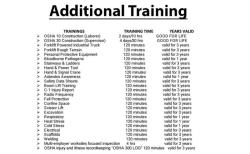What are the training requirements for OSHA?
The Occupational Safety and Health Administration (OSHA) in the United States establishes training requirements to ensure that workers and employers have the necessary knowledge and skills to maintain a safe and healthy workplace. OSHA training requirements vary based on the industry and specific hazards present in the workplace. Here are some key aspects of OSHA training requirements:
General Industry vs. Construction Industry:
- OSHA has separate sets of standards for general industry and construction. Training requirements differ between these sectors, and employers must comply with the relevant standards based on their industry.
Hazard Communication (HazCom) Training:
- HazCom training is required to inform employees about the hazards of chemicals present in the workplace. This includes information about chemical labeling, safety data sheets (SDS), and the proper use of personal protective equipment (PPE).
Bloodborne Pathogens Training:
- Employees at risk of occupational exposure to blood or other potentially infectious materials must receive training on bloodborne pathogens. This training covers the risks, prevention, and response to potential exposure incidents.
Respiratory Protection Training:
- Employers must provide respiratory protection training for employees required to use respirators. This includes information on the proper use, maintenance, and limitations of respiratory protection devices.
Lockout/Tagout Training:
- Employees involved in servicing and maintenance of machines and equipment where the unexpected startup could occur must receive training on lockout/tagout procedures to control hazardous energy.
Fall Protection Training:
- Workers exposed to fall hazards in construction must receive training on fall protection measures. This includes the use of guardrails, safety nets, personal fall arrest systems, and other protective measures.
Confined Space Entry Training:
- Employees who enter confined spaces must receive training on the hazards associated with confined space entry, as well as proper entry procedures, communication, and emergency response.
Electrical Safety Training:
- Workers exposed to electrical hazards must receive training on electrical safety practices, including the recognition of electrical hazards and the use of safe work practices.
Forklift and Powered Industrial Truck Training:
- Employees authorized to operate forklifts or other powered industrial trucks must undergo training to ensure safe operation and prevent accidents.
Personal Protective Equipment (PPE) Training:
- Employers are required to provide training on the proper use, selection, maintenance, and limitations of personal protective equipment required for specific job tasks.
Emergency Action Plan and Fire Prevention Plan Training:
- Employers must establish and implement emergency action plans and fire prevention plans. Employees must be trained on the procedures to follow in case of emergencies, including evacuation routes and fire response.
It's important to note that specific OSHA standards may have additional training requirements based on the hazards present in the workplace. Employers are responsible for identifying the applicable standards and ensuring that employees receive the required training. Additionally, training should be provided to new employees, when job duties change, and periodically to ensure ongoing awareness and compliance with safety standards.
What are the mandatory training prerequisites outlined by OSHA for various industries?
OSHA's training requirements primarily fall into two categories: general training applicable to all workplaces and industry-specific training covering specific hazards and risks unique to certain fields.
General Training:
- Bloodborne Pathogens & Exposure Control: Applies to employees with occupational exposure to potentially infectious human blood or other bodily fluids.
- Hazard Communication Standard: Employees must be trained on the hazardous chemicals they may encounter in their workplace, including chemical labels, safety data sheets (SDS), and safe handling procedures.
- Respiratory Protection Standard: Applies to employees using respirators for respiratory protection. Training covers respirator selection, fit testing, maintenance, and safe use.
- Lockout/Tagout Standard: Trains employees on procedures for safely de-energizing equipment before performing maintenance or servicing.
- Electrical Safety Standard: Covers working safely with electrical hazards, including training on safe work practices, hazard identification, and potential consequences of electrical contact.
Industry-Specific Training:
- Construction: OSHA offers various mandatory training programs like Construction Outreach Training Program (COT) and Fall Protection Training. Specific requirements depend on the construction activity and employee role.
- General Industry: Training programs cover topics like Permit-Required Confined Spaces, Machine Guarding, Welding/Cutting/Brazing, etc., depending on the specific hazards encountered in the workplace.
- Maritime: Training requirements vary based on the type of vessel and employee duties. Examples include Basic Safety Training, Fire-Fighting and Fire Prevention, Lifeboat Drills, etc.
- Disaster Site Worker: Training covers topics like hazard identification, personal protective equipment, decontamination procedures, and working safely in disaster zones.
Additional Points:
- These are just a few examples; specific training requirements can vary depending on the specific regulations applicable to your workplace.
- OSHA mandates employers to provide training by qualified trainers and ensure employees understand the training content.
- Training records must be maintained for documentation and inspection purposes.
It's crucial to consult OSHA's specific standards and regulations for your industry to ensure you understand all mandatory training requirements. You can find detailed information on OSHA's website or contact OSHA directly for assistance.
Remember, proper training is essential for preventing workplace accidents and injuries. By complying with OSHA regulations and providing adequate training to your employees, you can create a safer and healthier work environment.
I hope this information helps! Let me know if you have any specific questions about training requirements in a particular industry.







